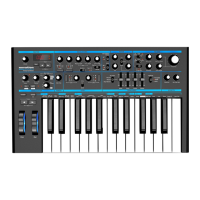
Do you have a question about the Novation Bass Station II and is the answer not in the manual?
| MIDI-keyboard number of keys | - keys |
|---|---|
| Product color | Black |
| Sound effects | Filtering, Overdrive, Resonators |
| Pitch bend wheel | Yes |
| Interface | USB |
| USB version | 2.0 |
| Headphone outputs | 1 |
| Firewire (IEEE 1394) ports | - |
| Mac operating systems supported | Mac OS X 10.7 Lion, Mac OS X 10.8 Mountain Lion, Mac OS X 10.9 Mavericks |
| Windows operating systems supported | Windows 7 Enterprise, Windows 7 Enterprise x64, Windows 7 Home Basic, Windows 7 Home Basic x64, Windows 7 Home Premium, Windows 7 Home Premium x64, Windows 7 Professional, Windows 7 Professional x64, Windows 7 Starter, Windows 7 Starter x64, Windows 7 Ultimate, Windows 7 Ultimate x64, Windows 8, Windows 8 Enterprise, Windows 8 Enterprise x64, Windows 8 Pro, Windows 8 Pro x64, Windows 8 x64 |
| Input voltage | 9 V |
| Power source type | DC |
| Depth | 273 mm |
|---|---|
| Width | 457.2 mm |
| Height | 76.2 mm |
Details the main controls and display functions of the synthesizer, including patch selection and volume.
Describes the primary and sub-octave oscillators, including waveform, pitch, and modulation controls.
Explains the Low Frequency Oscillator section, covering delay/speed controls and waveform selection.
Details how signals from oscillators, noise, and external inputs are mixed together.
Covers the filter types (Classic, Acid), shape, slope, frequency, and resonance controls.
Explains the ADSR envelope controls and their assignment to amplitude or modulation.
Describes the arpeggiator controls for tempo, rhythm, mode, and octaves.
Details the glide time control for portamento effects.
Covers the Distortion and Osc Filter Mod effects available on the synthesizer.
Explains how to enable/disable local control for MIDI operation and keyboard response.
Provides a detailed breakdown of the primary and sub-octave oscillators and their controls.
Details the functionality of the mixer, combining multiple sound sources.
Explains filter types, shape, slope, frequency, resonance, and overdrive controls.
Details the ADSR envelope parameters (Attack, Decay, Sustain, Release) and their controls.
Explains the portamento effect, allowing notes to glide sequentially.
Details the Distortion and Osc Filter Mod effects.
Describes the capabilities and modulation routes for LFO 1.
Describes the capabilities and modulation routes for LFO 2.
Describes the 32-note step sequencer controls for recording, playing, and editing sequences.